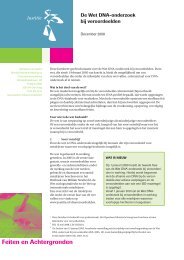INTERPOL HANDBOOK ON DNA DATA EXCHANGE AND PRACTICE
INTERPOL HANDBOOK ON DNA DATA EXCHANGE AND PRACTICE
INTERPOL HANDBOOK ON DNA DATA EXCHANGE AND PRACTICE
Create successful ePaper yourself
Turn your PDF publications into a flip-book with our unique Google optimized e-Paper software.
•crime scene investigator (csi)When the CSI arrives at the scene, the actions of the first responder and the firstattending officer will determine how much evidence they are able to collect. A CSIshould be trained in evidence collection (see Training) and be knowledgeable in thetypes of evidence present that can help to convict a suspect.In this scenario, it is difficult to locate evidence due to the area surrounding the scene.It is impossible to determine how many people have walked down the corridor andleft trace evidence, and therefore it is difficult (if not impossible) to single out evidencethat was left by the perpetrator. In this particular scenario, no fingerprints or footprintscould be identified, so the most valuable evidence is the clothing and the body itself.A medical examination will be carried out and the underwear will be analysed for thepresence of <strong>DNA</strong> and trace evidence (e.g. hairs, textile damage, fibres). It may also bepossible to take a swab of the door handle and obtain a <strong>DNA</strong> profile using state-of-theart<strong>DNA</strong> techniques (see In the Laboratory).However, each crime scene is different and there are many types of biological evidencethat can be present. Biological evidence can be transferred to an individual’s body orclothing or to an object or crime scene directly. Once liquid biological specimens havebeen deposited, they become stains and adhere to the surface or the substrate. Nonfluidbiological evidence, such as tissue, bone or hair, can also be transferred by directcontact and deposit. There are hundreds of varieties of physical evidence commonlysubmitted for examination to forensic science laboratories. Evidence that could besubjected to <strong>DNA</strong> analysis is generally limited to things that are biological in nature. Thefollowing table consists of biological materials from which <strong>DNA</strong> has been successfullyisolated and analysed:Table 1: Biological materials and how <strong>DNA</strong> can be isolated and analysedbiologicalmaterialsBloodBoneDandruffHair(s)Hair shaftshow to isolate and analyse for dnaBlood may be found in the form of pools, drops, splashes and smears. It maybe flaked, liquid or dried.Bone samples of badly decomposed bodies can be used for <strong>DNA</strong> analysis.Certain skin complaints result in excessive amounts of scalp and skin tissuethat may be suitable for <strong>DNA</strong> analysis.<strong>DNA</strong> is contained in the hair root and in any scalp cells surrounding theroot of a plucked hair. A single plucked head hair may have sufficient cellularmaterial attached for <strong>DNA</strong> analysis. In contrast, naturally shed hairs, as oftenfound on clothing, do not normally have sufficient <strong>DNA</strong> material associatedwith them for analysis. It is difficult to assess the quality of a hair root withoutexamining it under a microscope, therefore all hairs shall be collected.There is no <strong>DNA</strong> in hair shafts suitable for standard STR profiling, althoughmitochondrial <strong>DNA</strong> analysis can be used on pieces of rootless hair.<strong>DNA</strong> SAMPLING<strong>AND</strong> EVIDENCE COLLECTI<strong>ON</strong>PAGE 21







